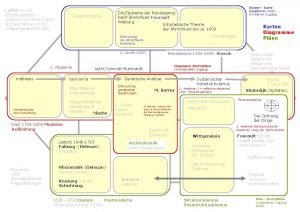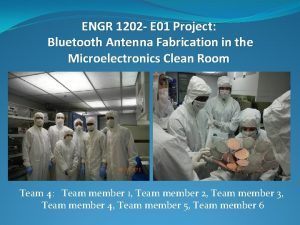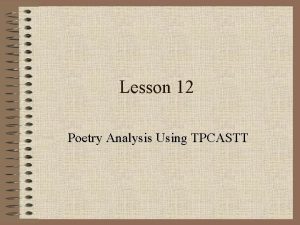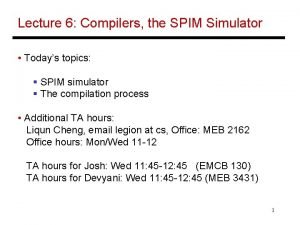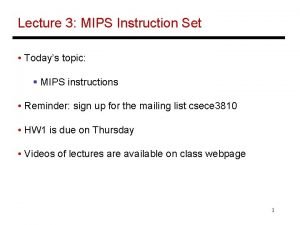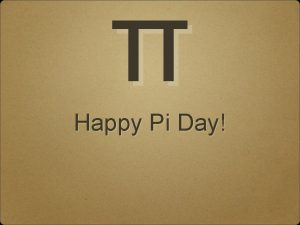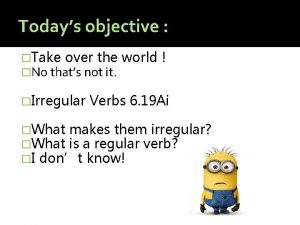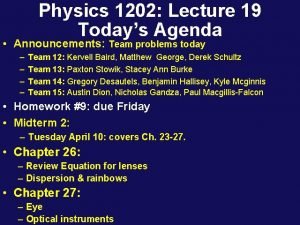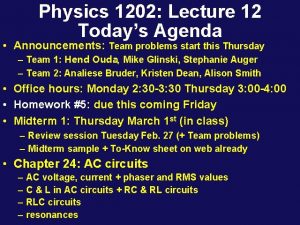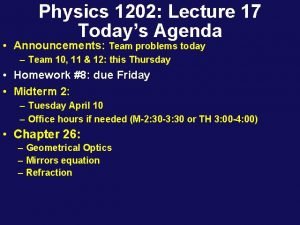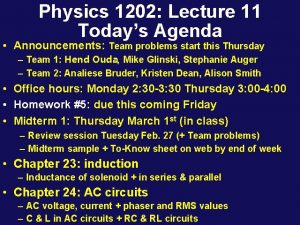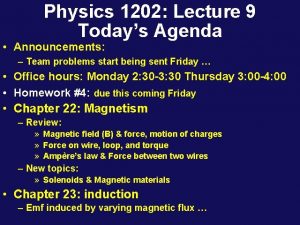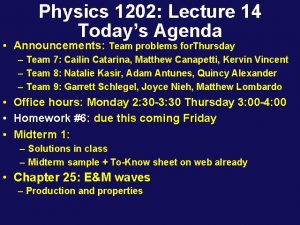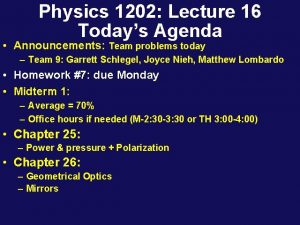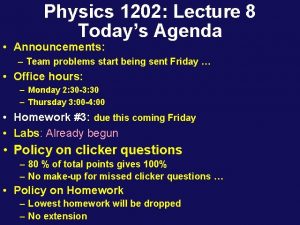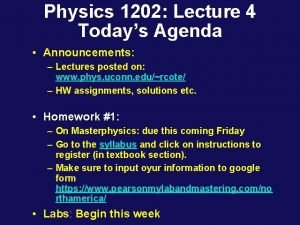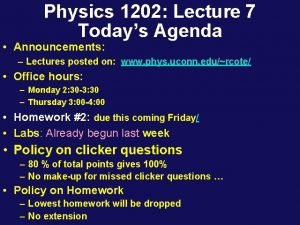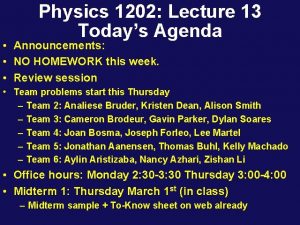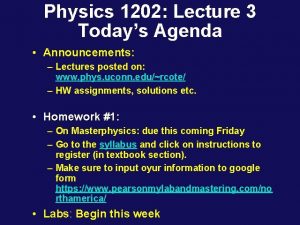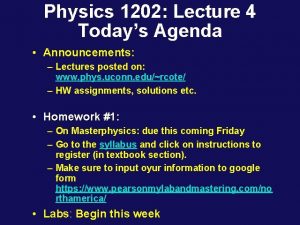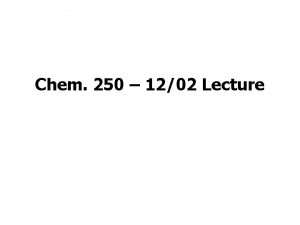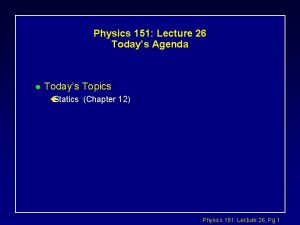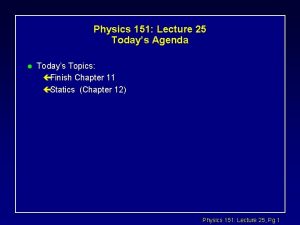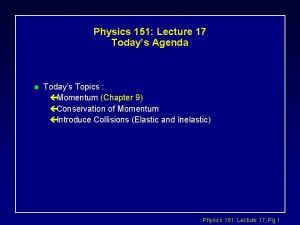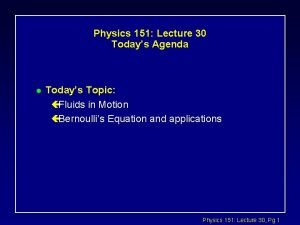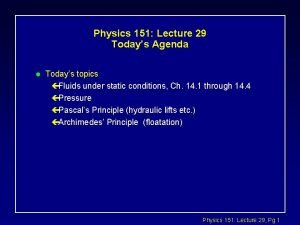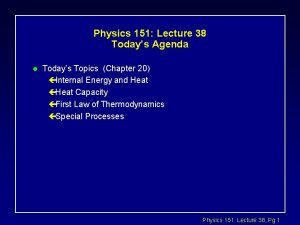Physics 1202 Lecture 22 Todays Agenda Announcements Team




































- Slides: 36

Physics 1202: Lecture 22 Today’s Agenda • Announcements: Team problems today – – – Team 16: Navia Hall, Laura Irwin, Eric Kaufman Team 18: Charles Crilly Jr, Kyle Eline, Alexandra Vail Team 19: Erica Allen, Shana Morel, Daniel Shoushani Team 20: Ugbad Awale, Jenny Ma, Randi Szabo Team 21: Erin Flajnik, Katerina Koch, Cindy Li • Homework #10: due Friday • Chapter 28: Physical Optics – Interference – Two-slit experiment – Interference in Reflected Waves – Diffraction/resolution

28 - Physical Optics e c n e r e f r e t n In o i t c a r f f i D

28 -1 Superposition and Interference • If two waves occupy the same space, their amplitudes add at each point. They may interfere either constructively or destructively.

Superposition and Interference • Light waves interfere with each other much like mechanical waves do • All interference associated with light waves arises when the electromagnetic fields that constitute the individual waves combine (superposition) Constructive interference Destructive interference

Conditions for Interference • For sustained interference between two sources of light to be observed, there are two conditions which must be met �The sources must be coherent • They must maintain Incoherent light beams pass a constant phase through each other, with no with respect to each obvious interference. other Although white-light interference �The waves must have is observed under certain conditions, it’s easier to see identical wavelengths interference when sources are monochromatic.

A wave through a slit Wavefronts: slit acts like point source Rays

A wave through two slits (two coherent point sources)

Intensity What happens when two light waves are present at the same point in space and time? What will we see? Intensity! Add Amplitudes! (electric fields or magnetic fields) Brightness ~ <Amplitude 2> ~ ½ E 02

Lecture 22 – Act 1 • Suppose laser light of wavelength l is incident on the two-slit apparatus as shown below. Which of the following statements are true? (A) There are new patterns of light and dark. (B) The light at all points on the screen is increased (compared to one slit). (C) The light at all points on the screen is decreased (compareed to two slits).

A wave through two slits l 1 q d l 2 q L Assume L is large, Rays are parallel Screen

A wave through two slits In Phase, i. e. Maxima when DP= l 2 - l 1 = d sinq = ml Out of Phase, i. e. Minima when DP = d sinq = (m+1/2)l d q DP= l 2 -l 1 = d sinq Screen

A wave through two slits In Phase, i. e. Maxima when DP = d sinq = ml + Out of Phase, i. e. Minima when DP = d sinq = (m+1/2)l +

Waves and Interference • Note that you could derive the reflectance equation (qi=q. R) using a particle model for light. Bouncing balls. • You could also derive Snell’s Law for particles. n 1 sin (qi)=n 2 sin(q 2) The particles change speed in different media (Newton did just this) • You cannot get a particle model for these interference effects. You would have to magically create particles at the bright spots and annihilate them at the dark spots. • Interference effects mean that light must be made up of waves.

28 -2 Young’s Two-Slit Experiment • In this experiment, the original light source need not be coherent • it becomes so after passing through the first very narrow single slit • • • Thomas Young first demonstrated interference in light waves from two sources in 1801 Light is incident on a screen with a narrow slit, So The light waves then pass through two narrow, parallel slits, S 1 and S 2 � The bright areas : constructive interference � The dark areas : destructive interference © 2017 Pearson Education, Inc.

28 -2 Young’s Two-Slit Experiment • The light on the screen has alternating light and dark fringes, corresponding to constructive and destructive interference. • The path difference is • Therefore, the condition for bright fringes (constructive interference) is:

28 -2 Young’s Two-Slit Experiment • This diagram illustrates the numbering of the fringes. • The dark fringes are between the bright fringes; the condition for dark fringes is: © 2017 Pearson Education, Inc.

28 -3 Interference in Reflected Waves • Reflected waves can interfere due to path length differences, and to phase changes upon reflection. • No phase change if reflected from a lower n • Half-wavelength phase change if reflected from a higher n, or from a solid surface. • There is also no phase change in the refracted wave.

Phase Change upon Reflection from a Surface/Interface Reflection from Optically Denser Medium (larger n) 180 o Phase Change Reflection from Optically Lighter Medium (smaller n) No Phase Change by analogy to reflection of traveling wave in mechanics

Interference in Thin Films 1800 phase change 1 Air Film Air no phase change 2 A wave traveling from air toward film undergoes 1800 phase change upon reflection. The wavelength of light ln in the medium with refraction index n is t The ray 1 is 1800 out of phase with ray 2 which is equivalent to a path difference ln/2. The ray 2 also travels extra distance 2 t. Constructive interference Destructive interference

constructive: 2 t = (m +1/2) ln destructive: 2 t = m ln constructive: 2 t = m ln destructive: 2 t = (m +1/2) ln Examples :

28 -3 Interference in Reflected Waves • Constructive interference: • Destructive interference: • Interference if light refracts and reflects from both surfaces of a thin film • This accounts for the colors we see in oil slicks and soap bubbles.

Newton’s Rings • Placing a curved piece of glass on flat glass gives interference patterns called Newton’s rings. • Monochromatic light is not necessary: white light is OK. • Newton’s rings can provide precision measurements of shapes and radii of lenses. If the bottom glass isn’t flat, or the top glass isn’t spherical or some other symmetric shape, Newton’s rings appear irregular, not circular.

Problem Solving with Thin Films Equation 1 phase reversal 2 t = (m + ½) l/n constructive 2 t = m l/n destructive 0 or 2 phase reversals destructive constructive

28 -3 Interference in Reflected Waves • Wavelength of light in a medium of index of refraction n: • Destructive interference (t= film thickness) • Constructive interference: • The rainbow of colors we see is due to the different wavelengths of light

28 -3 Interference in Reflected Waves • DVDs depend on interference for their functioning. The signal is encoded as tiny bumps in the surface, and the reflected laser varies in intensity depending on whether it is reflecting from a bump or not.

Change of Phase Due to Reflection Lloyd’s mirror P 2 S P 1 L I Mirror The reflected ray (red) can be considered as an original from the image source at point I. Thus we can think of an arrangement S and I as a double-slit source separated by the distance between points S and I. An interference pattern for this experimental setting is really observed …. . but dark and bright fringes are reversed in order This mean that the sources S and I are different in phase by 1800 An electromagnetic wave undergoes a phase change by 1800 upon reflecting from the medium that has a higher index of refraction that one in which the wave is traveling.

28 -4 Diffraction • A wave passing through a small opening will diffract, (e. g. , water waves) – After the opening, there are waves traveling in directions other than the direction of the original wave – Diffraction is the bending of waves as they pass by an obstacle or through an opening. • This is why we hear sound even if not in a straight line from the source – sound waves will diffract around corners and other barriers • The amount of diffraction depends on the wavelength, which is why we can hear around corners but not see around them.

Experimental Observations: (pattern produced by a single slit ? )

Huygen’s Principle • Huygen assumed that light is a form of wave motion rather than a stream of particles Christian Huygens 1629 – 1695 ● ● ● Huygens’ Principle has two parts: Each point on a wave front is the source of a spherical wavelet that spreads out at the wave speed. At a later time, the shape of the wave front is the curve that is tangent to all the wavelets.

How do we understand this pattern ? First Destructive Interference: (a/2) sin Q = ± l/2 sin Q = ± l/a Second Destructive Interference: (a/4) sin Q = ± l/2 sin Q = ± 2 l/a mth Destructive Interference: sin Q = ± m l/a m=± 1, ± 2, … See Huygen’s Principle

So we can calculate where the minima will be ! sin Q = ± m l/a m=± 1, ± 2, … So, when the slit becomes smaller the central maximum becomes ? Why is the central maximum so much stronger than the others ?

Other Examples Light from a small source passes by the edge of an opaque object and continues on to a screen. A diffraction pattern consisting of bright and dark fringes appears on the screen in the region above the edge of the object. What type of an object would create a diffraction pattern shown on the left, when positioned midway between screen and light source ? • A penny, … • Note the bright spot at the center.

28 -5 Resolution • Diffraction through a small circular aperture results in a circular pattern of fringes. This limits our ability to distinguish one object from another when they are very close. • The location of the first dark fringe determines the size of the central spot: © 2017 Pearson Education, Inc.

Resolution (single-slit aperture) Rayleigh’s criterion: • two images are just resolved WHEN: When central maximum of one image falls on the first minimum of another image sin Q = l / a Qmin ~ l / a

Resolution (circular aperture) Diffraction patterns of two point sources for various angular separation of the sources Rayleigh’s criterion for circular aperture: Qmin = 1. 22 ( l / a)

Recap of Today’s Topic : • Announcements: Team problems today – – – Team 16: Navia Hall, Laura Irwin, Eric Kaufman Team 18: Charles Crilly Jr, Kyle Eline, Alexandra Vail Team 19: Erica Allen, Shana Morel, Daniel Shoushani Team 20: Ugbad Awale, Jenny Ma, Randi Szabo Team 21: Erin Flajnik, Katerina Koch, Cindy Li • Homework #10: due Friday • Chapter 28: Physical Optics – Interference – Two-slit experiment – Interference in Reflected Waves – Diffraction/resolution
 Finite
Finite +1202
+1202 Bluetooth antenna length
Bluetooth antenna length Todays agenda
Todays agenda Pvu announcement today
Pvu announcement today R/announcements!
R/announcements! Church announcements
Church announcements Fahrenheit 451 burning
Fahrenheit 451 burning Potentiial
Potentiial General announcements
General announcements 01:640:244 lecture notes - lecture 15: plat, idah, farad
01:640:244 lecture notes - lecture 15: plat, idah, farad Agenda sistemica y agenda institucional
Agenda sistemica y agenda institucional Standardagenda
Standardagenda Classical mechanics
Classical mechanics Physics 101 lecture
Physics 101 lecture Physics 101 lecture 1
Physics 101 lecture 1 Physics 101 lecture notes pdf
Physics 101 lecture notes pdf Physics notes pdf
Physics notes pdf Atmospheric physics lecture notes
Atmospheric physics lecture notes Team spirit becomes team infatuation
Team spirit becomes team infatuation Team spirit becomes team infatuation
Team spirit becomes team infatuation The white team cheers for the blue team, just like
The white team cheers for the blue team, just like Todays generations
Todays generations Today is class
Today is class Multiple choice comma quiz
Multiple choice comma quiz Todays worldld
Todays worldld What is todays temperature
What is todays temperature Todays globl
Todays globl Whats todays wordlw
Whats todays wordlw Chapter 13 marketing in todays world
Chapter 13 marketing in todays world Todays plan
Todays plan Todays sabbath lesson
Todays sabbath lesson Sabbath welcome
Sabbath welcome Todays match
Todays match Todays health
Todays health How to identify simile
How to identify simile Todays objective
Todays objective

